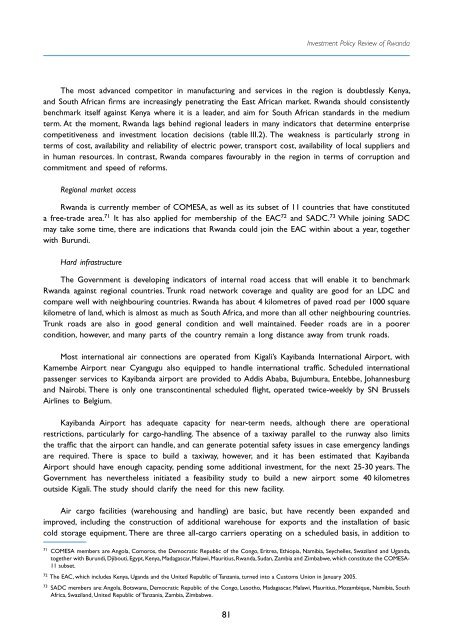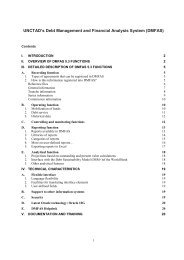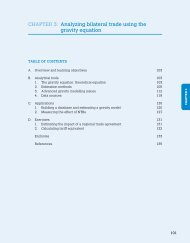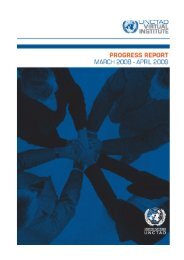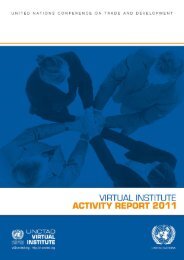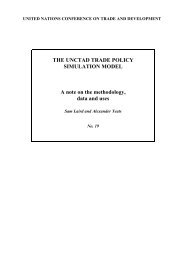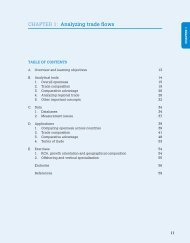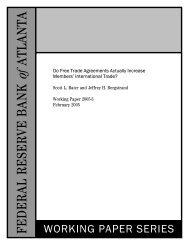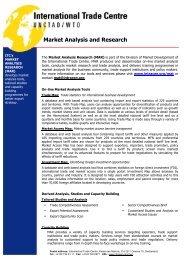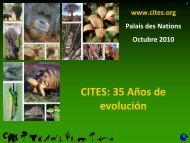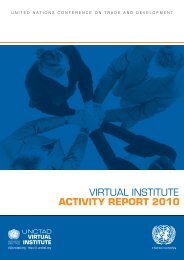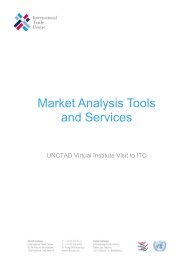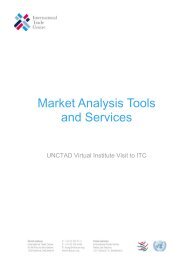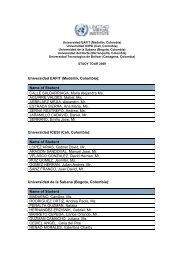Investment Policy Review - Rwanda - UNCTAD Virtual Institute
Investment Policy Review - Rwanda - UNCTAD Virtual Institute
Investment Policy Review - Rwanda - UNCTAD Virtual Institute
You also want an ePaper? Increase the reach of your titles
YUMPU automatically turns print PDFs into web optimized ePapers that Google loves.
<strong>Investment</strong> <strong>Policy</strong> <strong>Review</strong> of <strong>Rwanda</strong><br />
The most advanced competitor in manufacturing and services in the region is doubtlessly Kenya,<br />
and South African firms are increasingly penetrating the East African market. <strong>Rwanda</strong> should consistently<br />
benchmark itself against Kenya where it is a leader, and aim for South African standards in the medium<br />
term. At the moment, <strong>Rwanda</strong> lags behind regional leaders in many indicators that determine enterprise<br />
competitiveness and investment location decisions (table III.2). The weakness is particularly strong in<br />
terms of cost, availability and reliability of electric power, transport cost, availability of local suppliers and<br />
in human resources. In contrast, <strong>Rwanda</strong> compares favourably in the region in terms of corruption and<br />
commitment and speed of reforms.<br />
Regional market access<br />
<strong>Rwanda</strong> is currently member of COMESA, as well as its subset of 11 countries that have constituted<br />
a free-trade area. 71 It has also applied for membership of the EAC 72 and SADC. 73 While joining SADC<br />
may take some time, there are indications that <strong>Rwanda</strong> could join the EAC within about a year, together<br />
with Burundi.<br />
Hard infrastructure<br />
The Government is developing indicators of internal road access that will enable it to benchmark<br />
<strong>Rwanda</strong> against regional countries. Trunk road network coverage and quality are good for an LDC and<br />
compare well with neighbouring countries. <strong>Rwanda</strong> has about 4 kilometres of paved road per 1000 square<br />
kilometre of land, which is almost as much as South Africa, and more than all other neighbouring countries.<br />
Trunk roads are also in good general condition and well maintained. Feeder roads are in a poorer<br />
condition, however, and many parts of the country remain a long distance away from trunk roads.<br />
Most international air connections are operated from Kigali’s Kayibanda International Airport, with<br />
Kamembe Airport near Cyangugu also equipped to handle international traffic. Scheduled international<br />
passenger services to Kayibanda airport are provided to Addis Ababa, Bujumbura, Entebbe, Johannesburg<br />
and Nairobi. There is only one transcontinental scheduled flight, operated twice-weekly by SN Brussels<br />
Airlines to Belgium.<br />
Kayibanda Airport has adequate capacity for near-term needs, although there are operational<br />
restrictions, particularly for cargo-handling. The absence of a taxiway parallel to the runway also limits<br />
the traffic that the airport can handle, and can generate potential safety issues in case emergency landings<br />
are required. There is space to build a taxiway, however, and it has been estimated that Kayibanda<br />
Airport should have enough capacity, pending some additional investment, for the next 25-30 years. The<br />
Government has nevertheless initiated a feasibility study to build a new airport some 40 kilometres<br />
outside Kigali. The study should clarify the need for this new facility.<br />
Air cargo facilities (warehousing and handling) are basic, but have recently been expanded and<br />
improved, including the construction of additional warehouse for exports and the installation of basic<br />
cold storage equipment. There are three all-cargo carriers operating on a scheduled basis, in addition to<br />
71<br />
COMESA members are Angola, Comoros, the Democratic Republic of the Congo, Eritrea, Ethiopia, Namibia, Seychelles, Swaziland and Uganda,<br />
together with Burundi, Djibouti, Egypt, Kenya, Madagascar, Malawi, Mauritius, <strong>Rwanda</strong>, Sudan, Zambia and Zimbabwe, which constitute the COMESA-<br />
11 subset.<br />
72<br />
The EAC, which includes Kenya, Uganda and the United Republic of Tanzania, turned into a Customs Union in January 2005.<br />
73<br />
SADC members are: Angola, Botswana, Democratic Republic of the Congo, Lesotho, Madagascar, Malawi, Mauritius, Mozambique, Namibia, South<br />
Africa, Swaziland, United Republic of Tanzania, Zambia, Zimbabwe.<br />
81


